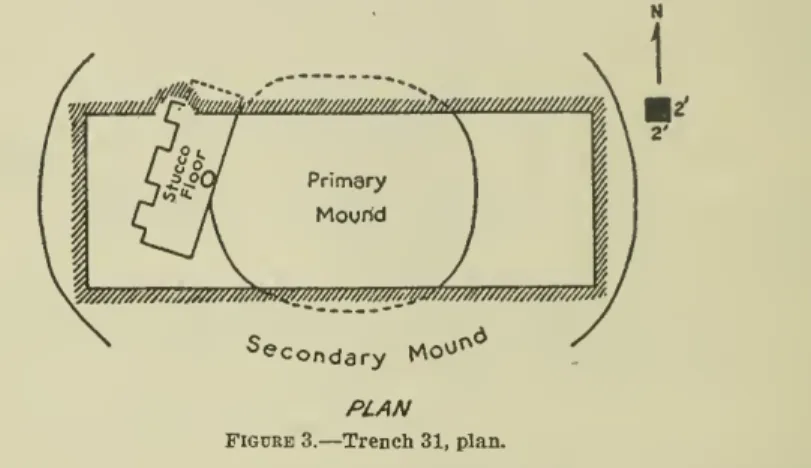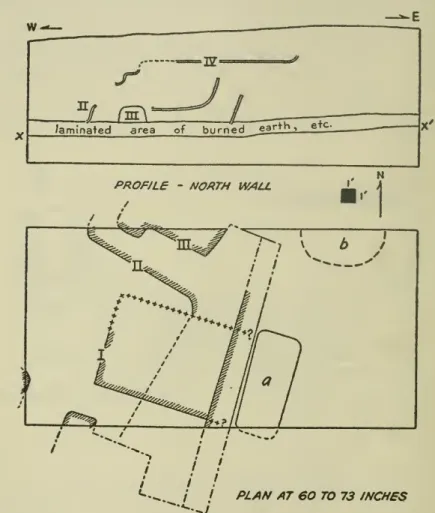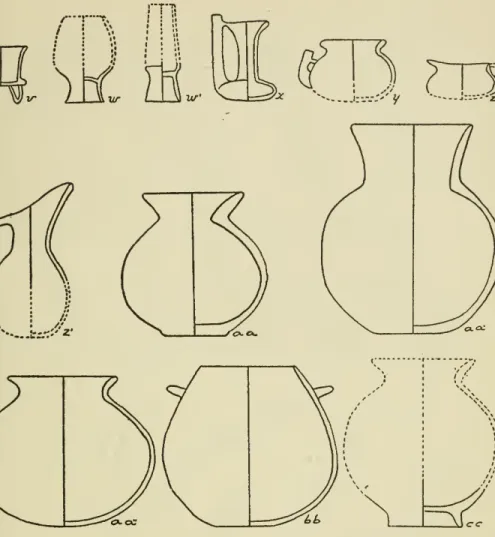LETTER OF TRANSMITTAL
CONTENTS
PLATES
COMTENTS VH
TEXT FIGURES
CERAMIC STRATIGRAPHY AT CERRO DE LAS MESAS, VERACRUZ, MEXICO
INTRODUCTION
THE LOCAL GEOGRAPHY
North of the central group, and extending some distance to the west, is an open almost level plain, on which there are but few mounds. A large one, at the southern end of the Central Mound Group, is said to contain all the water.
THE DEPOSITS
Other smaller pits are found here and there on the site, and they are particularly numerous in the Småhøj locality in the northwest. However, the excavations in the industrial zone testify that in the earliest periods the topography of the site differed somewhat, and that spring sands and trickling water, if not streams, were close at hand.
THE EXCAVATIONS
One of the incense burners was apparently in the shape of a Tlaloc (or with an attached mask representing that deity), covered with white stucco paint. Trench 15 was dug for the purpose of clearing a structure (or foundation of a structure) in the eastern part of the Monument Plaza.
PLAN
Under the level of the burials, a lot of 5 cylindrical flat-bottomed pots of thick bad. In removing the northern wheelbarrow ramp in the northwest corner of the trench, some heavy incensario fragments were encountered.
20 BUREAU OF AMERICAN ETHNOLOGY [BULL. 141
The excavation was lowered to 110 inches, with a reduced cut 4 feet wide dug 36 inches more along the south wall of the trench. Layers similar and 2 to 3 inches thick were noted on the south side of the trench at 48 and 79 inches.
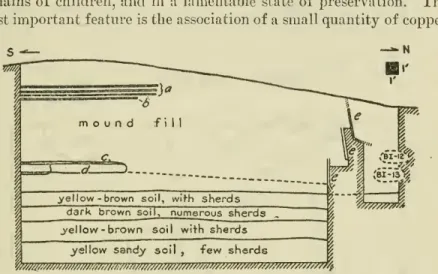
PROPJLB ' NOATH WALL
The mound at a depth of 70 to 84 inches consisted of irregular and interrupted areas of burnt earth, etc.
Immediately below were the skull and ribs from the (secondary) burial, on top of a pile of long bones. At a point almost immediately below the first double row of jars, below the second floor, was another double row of covered vessels of the same size and type, also containing skulls and cervical vertebrae.
CERRO DE LAS MESAS WARES
The repetition in most of these ceramic units of the same vessel shape allows for a few generalizations regarding the dominant shape patterns. The most common fat is one of the same clay as the paste, fired in the same shade as on the outer parts of the walls.
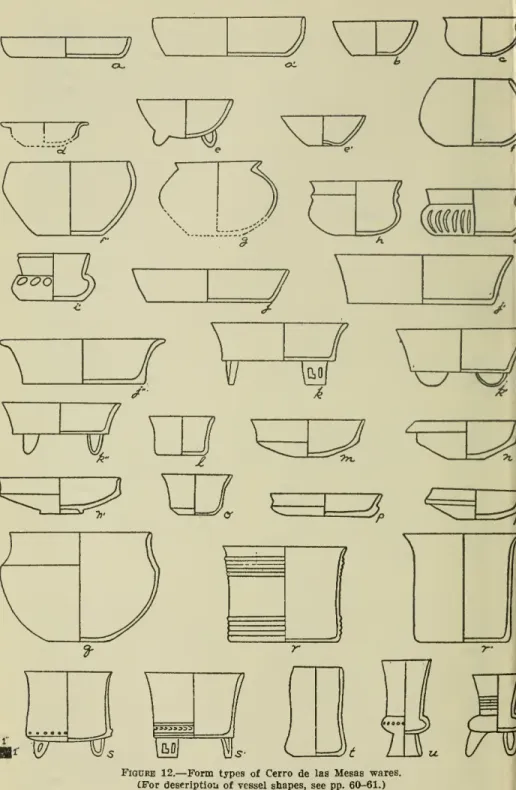
32 BUREAU OF AMERICAN ETHNOLOGY [BULL. 141
The writer believes that this is a manifestation of a ceramic type widely distributed in both time and space in the Veracruz area. Little can be said about the decorative motifs of this pottery, due to the combined circumstances of the perishable nature of the paint and the small size of the sherds in the collections.
BROWN WARE
In addition, pre- and post-bake cutting was often applied, apparently to complement painted accent patterns. Typical are the rows of parallels, vertical or horizontal, bands of triangles, open and crossed (fig. 82 to 90).
POLISHED BROWN WARE
The paste appears to be the same as that of normal Brownware, of the same colors and with the same tempering material. The ware is much like the "Polished Gray ware" of Monte AlbanI-II, in which similar finish, vessel forms, and often even the same olive-.
RED WARE
In one, the most common, it is used in wide horizontal bands, for example around the rim and bottom or around the middle of the vessel. Design elements are often formed from the lower brown coating, and the surrounding area is in red.
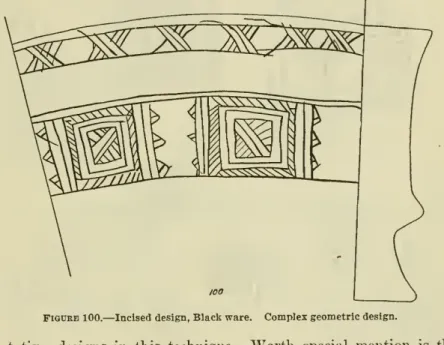
40 BUREAU OF AMERICAN ETHNOLCKSY [BULL. 141
The colors, white, red, green, black, and yellow, appear to be of the same material as those on the painted gourd found in Trench 19. DRUCKER] CERAMIC STRATIGRAPHY, CERRO DiE LAS MESAS 47 closely resemble the black or red of the "natural base color". In fact, this material is not used in any of the true polychromes, at least not in a recognizable form.
Unfortunately, little can be said about the subjects of the representative designs, as substantial well-preserved sherds of the ware are few (cf. In another instance, a row of animal(?) heads forms part of the border of the main design panel. This ceramic group is closely related to the Black-and-White-on-Oath ware, and thereby to Brown Polychrome, but gains separate status due to the different decorative techniques.
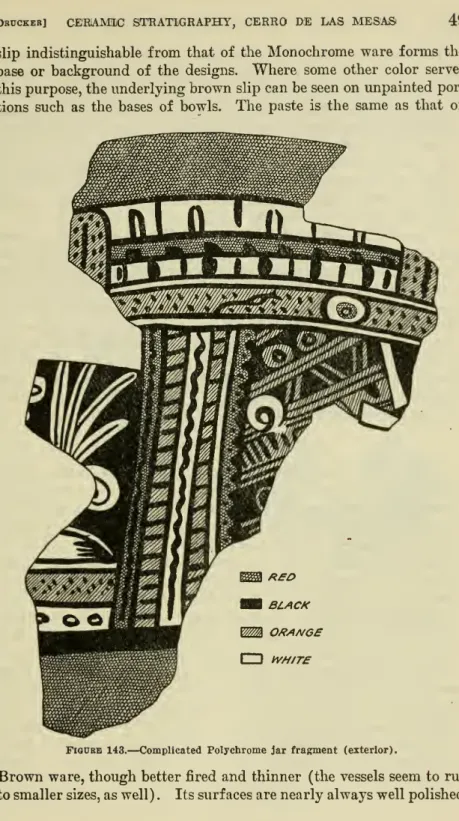
1 BLACK
52 BUREAU OF AMERICAN ETHNOLOOY [BDLL. 141
DBUCKEB] CE'RIAMEC STRATIGRAPHY, CERRO DE LAS MESAS 53
Red-on-Orange incised can only be classified as a Polychrome if we count the basic paste color displayed in the incised areas as a separate tone. Because of the resemblance to the Black-on-Red Incisedware, and since, moreover, its vertical distribution can be shown. Almost always three to five narrow lines of red run around the inner edge, and broad stripes, containing the post-fire incised decorative elements, run around the outer edge.
The collections include a number of examples of zoomorphic vessel feet and zoomorphic ringed cylindrical handles with zoomorphic ornament that undoubtedly belong to one or the other of the Polychrome wares, but in the absence of nearly complete specimens it is difficult to assign them to a specific container (p. 53,). Slides vary from red to orange-brown; some have the patterning highlighted by etched designs after firing.
DRUCKKR] CERAMIC STRATIGRAPHY, CERRO DE LAS MESAS 55
There are in the collections numerous sherds and a number of complete examples of a type of unpolished, retracted, shallow bowl of pale yellow sandpaste, measuring 10 to 16 inches in diameter and 9 to 10 inches deep. Most of these bowls have a wide stripe of red paint around the rim; a few have similar stripes on the inside. The rim and interior are covered with a well-polished brown slip having the same color range as that of brown goods, although tending to the darker olive brown shades (orange brown etc. occur but are not common).
Rim sherds with small triangular tabs occur, but the lack of complete vessels makes it impossible to determine whether they were a standard feature or not, or how many were in each mound.
MONUMENTAL WARE
These vessels were invariably poorly fired, to the point of crumbling on exposure and consequent drying of the paste. However, noresterable vessels of this type were found, so that it is not possible to say whether they were of the shape with a flat, slightly flared side known from Teotihuacan, or of the convex variety found at Tres Zapotes. The only example of Plumbate was the complete flute pot found in trench 15, under conditions that make its temporal relationship with the local ceramic column difficult (Fig. 10,d).
It should be understood that the carcase is flat and the rims are of the simple direct type, unless otherwise stated. A small proportion of the specimens in the collections have heads belonging to this type pasted on crude cylindrical bodies with appliques of arms and legs (pi. 32). Another small group represents ape-like beings with protruding foreheads, round eyes and marked prognathism (pi. 35).
DRUCKHB] CERIAMIC STRATIGRAPHY, CERRO DIE LAS MESAS 65
66 BUREAU OF AMERICAN ETHNOLOGY [BOLL. 141
DRUCKER] CERAMIC STRATIGRAPHY, CERRO DE LAS MESAS 67 modeled ornaments — heads of men or animals, hands, feet, flowers, etc
DRUCKER] CERAMIC STRATIGRAPHY, CERRO DE LAS MESAS 67 modeled ornaments — heads of men or animals, hands, feet, flowers, etc. Small double rings of clay, usually of brown or black cloth, with the planes of the loops at right angles, occur in the deposits.
STRATIGRAPHY WARE DISTRIBUTIONS
Changes in product frequencies and the appearance of new traits can be accounted for in terms of crop growth, both internally stimulated and externally influenced varieties. The second important point is the clear division of frequencies into two main horizons, one of which can be further subdivided. Partly, perhaps, because of the small samples, there appears to be considerable irregularity in the sizes of some goods.
The lowest part of the zone.The lower is distinguished by the absence of the aforementioned wares (the single Dull BuffPolychrome sherd at the 144- to 156-inch level is probably lost), and the presence of relatively larger quantities of Whiteware. In view of the fact that the mounds are themselves secondary deposits, it was not considered worthwhile to save all the sherds for counts, etc. Black on white with fine line, and varieties^ofTanPolychrome, indicate an even later position than the upper layers of the strata-.
78 BUHEAU OF AAIERICAN ETHNOIXKJY Table 10.— Ware occurrence in Mound Groups
The bulk of the ceramic material from trench 34 consisted of pots containing selections of sea shells, etc. The spectacular and important jade hoard from Trench 34 was placed in Spodnja II on the basis of the ceramic contents of the mound. Only occasional pieces were found in other ditches, none in the trenches at the Mala Gomila site from the above period.
II high, occasional floors, etc., are covered with this material, but most of the floors, stairs, and other elements were covered with clay. If these several types of objects do in fact constitute a complex or part of a complex, as has been previously suggested, we have for the first time to place it in a definite period. There are a few items in the collections from procurement sources that are not represented in the excavations.
COMPARATIVE ANALYSIS AND CHRONOLOGY
In addition to local specializations of the handmade point pattern, shapes referencing Rancho de las Animas appear, as well as a variety of mold-made types, including extended variants of Laughing Faceforms. It is likely that the few Aztec figurines collected from the surface of the site, especially trade pieces, refer to this period. Drdckeb] CERAMiTC STRATIGRAPHY, CERRO DE LAS MESAS 85 In fact, at Cerro de las Mesas there exists a continuous ceramic column extending from the fifteenth century to a point roughly equivalent to that of the early Teotihuacan III.
The strong ties of Cholula to Tlaxcala and southward to the heart of the Mixteca in Oaxaca. In short, the modern designation of the Cerro de las Mesas region as the "Mistequilla" undoubtedly has a good ethnic derivation. Since this phase is not sharply set off from the predecessor, but rather gradually emerges from it, we must look to the earliest levels of Cerro de las Mesas for an earlier set of Highland influences, and possibly immigrations, that occurred at the end of Lower II was renewed and which continued to mark the end of the prehistoric occupation of the.
INDEX
90 INDEX
92 INDEX Mound materials, burials, 8-9
Complicated polychrome ware, 48 Dull Buff polychrome ware, 45 Fine-line black-on-white ware, 54 Monumental ware, 57.
94 INDEX
White-slipped sherds of larger than life-size figures, 13. BUREAU OF AMERICAN ETHNOLOGY BULLETIN 141 PLATE 1. Brown polychrome, black-white-on-red, and complicated polychrome. BUREAU OF AMERICAN ETHNOLOGY BULLETIN Ml PLATE 5. Black-White-and-Orange-on-Buff. d, xMixteca polychrome; Red-White-Black-and-Grey-on-Orange. BUREAU OF AMERICAN ETHNOLOGY BULLETIN 141 PLATE 9. BUREAU OF AMERICAN ETHNOLOGY BULLETIN 141 PLATE 11. aand/;,Olias containingskulls; b shows relationship with stucco la\'ers.
INCHES
Red goods from trench 34; c, Coarse bowl with red edge from channel 19; d, Red-on-Orange Incised bowl fragment, with unique design, from well 10; e-j, figurine molds, purchase collection.
NCHES
I FIGURINES WITH HOLLOW BODIES
MONUMENTAL WARE: FRAGMENTS OF IDOLS
